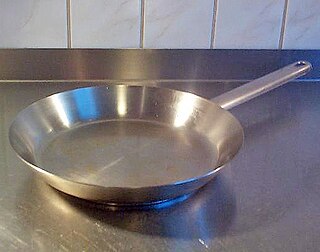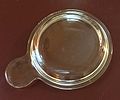Glass-ceramics are polycrystalline materials produced through controlled crystallization of base glass, producing a fine uniform dispersion of crystals throughout the bulk material. Crystallization is accomplished by subjecting suitable glasses to a carefully regulated heat treatment schedule, resulting in the nucleation and growth of crystal phases. In many cases, the crystallization process can proceed to near completion, but in a small proportion of processes, the residual glass phase often remains.

Cookware and bakeware is food preparation equipment, such as cooking pots, pans, baking sheets etc. used in kitchens. Cookware is used on a stove or range cooktop, while bakeware is used in an oven. Some utensils are considered both cookware and bakeware.

Pyrex is a brand introduced by Corning Inc. in 1915 for a line of clear, low-thermal-expansion borosilicate glass used for laboratory glassware and kitchenware. It was later expanded in the 1930s to include kitchenware products made of soda–lime glass and other materials.

Corning Incorporated is an American multinational technology company that specializes in specialty glass, ceramics, and related materials and technologies including advanced optics, primarily for industrial and scientific applications. The company was named Corning Glass Works until 1989. Corning divested its consumer product lines in 1998 by selling the Corning Consumer Products Company subsidiary to Borden.

Borosilicate glass is a type of glass with silica and boron trioxide as the main glass-forming constituents. Borosilicate glasses are known for having very low coefficients of thermal expansion, making them more resistant to thermal shock than any other common glass. Such glass is subjected to less thermal stress and can withstand temperature differentials without fracturing of about 165 °C (300 °F). It is commonly used for the construction of reagent bottles and flasks, as well as lighting, electronics, and cookware.

Olde English 800 is a brand of American malt liquor brewed by the Miller Brewing Company. It was introduced in 1964, and has been produced by the company since 1999. It is available in a variety of serving sizes including, since the late 1980s, a 40-U.S.-fluid-ounce (1,200-milliliter) bottle.

Corning Ware, also written CorningWare, was originally a brand name for a unique glass-ceramic (Pyroceram) cookware resistant to thermal shock. It was first introduced in 1958 by Corning Glass Works in the United States. The brand was later spun off with the sale of the Corning Consumer Products Company subsidiary, now known as Corelle Brands.

Corelle Brands, LLC is an American kitchenware products maker and distributor based in Downers Grove, Illinois.

Beer glassware comprise vessels made of glass, designed or commonly used for serving and drinking beer. Styles of glassware vary in accord with national or regional traditions; legal or customary requirements regarding serving measures and fill lines; such practicalities as breakage avoidance in washing, stacking or storage; commercial promotion by breweries; artistic or cultural expression in folk art or as novelty items or usage in drinking games; or to complement, to enhance, or to otherwise affect a particular type of beer's temperature, appearance and aroma, as in the case of its head. Drinking vessels intended for beer are made from a variety of materials other than glass, including pottery, pewter, and wood.
Stanley Donald Stookey was an American inventor. He had 60 patents in his name related to glass and ceramics, some patents solely his and others shared as joint patents with other inventors. His discoveries and inventions have contributed to the development of ceramics, eyeglasses, sunglasses, cookware, defense systems, and electronics.

Corelle is a brand of glassware and dishware. It is made of Vitrelle, a tempered glass product consisting of two types of glass laminated into three layers. It was introduced by Corning Glass Works in 1970, but is now manufactured and sold by Corelle Brands.

Descoware is a discontinued brand of porcelain- or enamel-coated cast-iron cookware Among notable Descoware pots are dutch ovens. Although Descoware is now little-remembered, specialist sources hold that it was the favorite cooking ware of American cooking instructor and television personality Julia Child, more so than Le Creuset, whose association with the chef has been widely reported. Child regularly used Descoware on her television show The French Chef. The Smithsonian Institution's installation about Child's kitchen featured a large orange Descoware pot on top of Child's own stove.

Home canning or bottling, also known colloquially as putting up or processing, is the process of preserving foods, in particular, fruits, vegetables, and meats, by packing them into glass jars and then heating the jars to create a vacuum seal and kill the organisms that would create spoilage.

Revere Ware was a line of consumer and commercial kitchen wares introduced in 1939 by the Revere Brass & Copper Corp. The line focuses primarily on consumer cookware such as skillets, sauce pans, stock pots, and tea kettles. Initially Revere Ware was the culmination of various innovative techniques developed during the 1930s, the most popular being construction of stainless steel with rivetlessly attached bakelite handles, copper-clad bases and rounded interiors for ease of cleaning. Over the next 40+ years, Revere Ware would introduce new series to position itself in competition with other manufacturers at various price points, or for specific specialty markets. In the early 1960s the profitability of Revere Ware began to level off. Coinciding with new series introductions, cost-cutting measures were implemented in the manufacture of the traditional cookware. The bakelite handles were changed from two piece to one, and the thickness of utensil walls and copper cladding were reduced.

The Inspired Home Show, formerly known as the International Home + Housewares Show, is an annual housewares show staged at McCormick Place in Chicago and organized by the International Housewares Association. In 2008, the Show covered 785,000 net square feet (72,900 m2) of exhibit space. It is one of top 20 largest trade shows in the U.S. and in the top 10 in Chicago.

A frying pan, frypan, or skillet is a flat-bottomed pan used for frying, searing, and browning foods. It is typically 20 to 30 cm in diameter with relatively low sides that flare outwards, a long handle, and no lid. Larger pans may have a small grab handle opposite the main handle. A pan of similar dimensions, but with less flared, more vertical sides and often with a lid, is called a sauté pan. While a sauté pan can be used as a frying pan, it is designed for lower-heat cooking.
Pyroceram is the original glass-ceramic material developed and trademarked by Corning Glass in the 1950s. Pyroceram is an opaque, white, glass material, commonly used in kitchenware, glass stove tops, wood stove doors, etc.. It has high heat tolerance and low thermal expansion.

Duralex is a French tempered glass tableware and kitchenware manufacturer located in La Chapelle-Saint-Mesmin in Loiret, France. Using a technique developed in the 1930s by Saint-Gobain, moulded glass is heated to 600 degrees Celsius then cooled very quickly, giving it an impact resistance that is twice superior to normal glass.
Visions is a brand of transparent stove top cookware created by Corning France and introduced to Europe during the late 1970s. In 1983, it was introduced in the United States and became the number one selling cookware set for a number of years. Visions is made of a transparent material belonging to the Pyroceram family of glass-ceramics. It is one of the few cookware lines that can be used on the range, in the oven, and under a broiler. It will withstand heat up to 850 °C (1,560 °F) with thermal traits similar to Corning Ware plus improved resistance to staining and the detrimental effects of acids and detergents. Visions is sold worldwide by Corelle Brands.



















